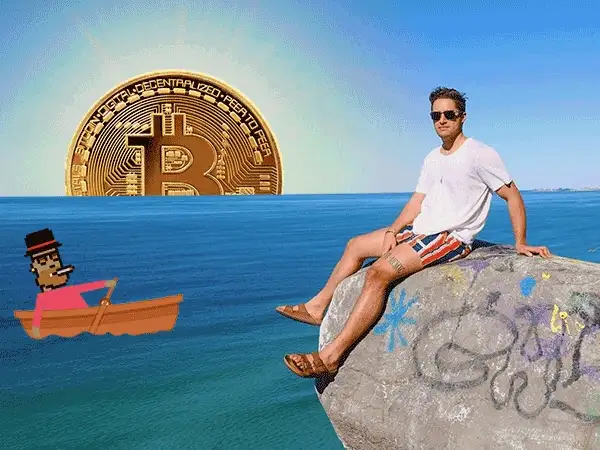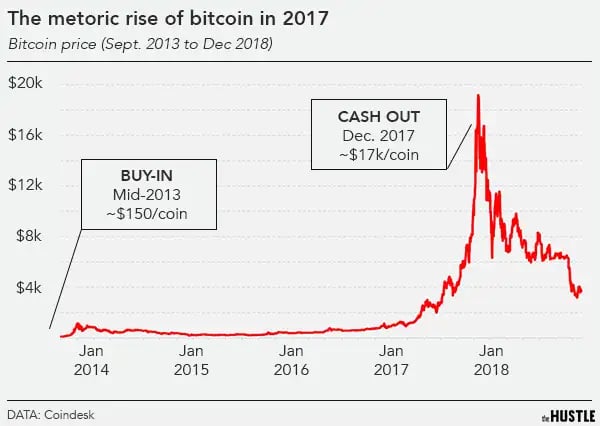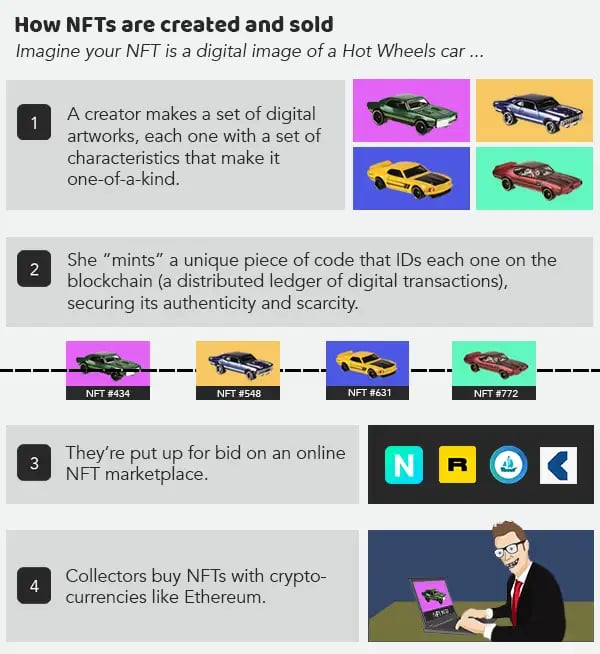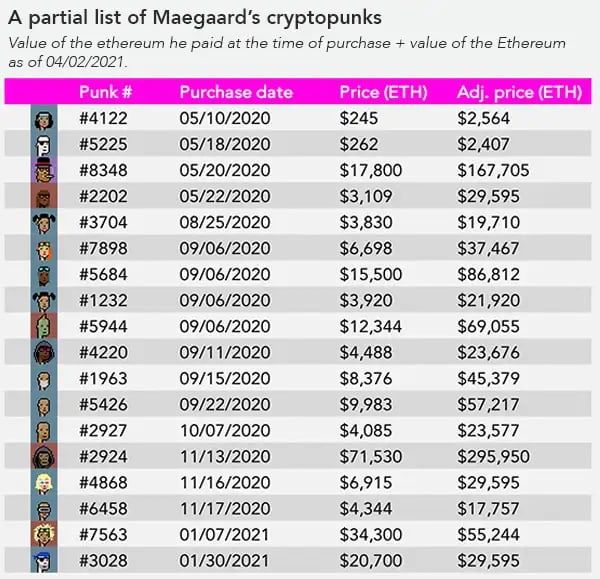In recent months, the internet has been rife with tales about young speculators making life-changing money on high-risk markets.

These traders usually opt to stay anonymous, veiled behind alphanumeric wallet addresses, burner Reddit accounts, and cartoon avatars.
But one successful crypto investor recently decided to share his story with The Hustle for the first time — and it’s a wild ride.
Daniel Maegaard, 30, of Brisbane, Australia, made a fortune not once, but twice: First, by hedging bets on various cryptocurrencies from 2013-2017, then, more recently, by getting in early on the explosion of non-fungible tokens (NFTs).
It’s a rare tale of how extreme risk-taking, timing, intuition, and a lot of luck resulted in a multi-million dollar payout.
And it began just 8 years ago, with an investment of a few thousand dollars.
The first fortune: Cryptocurrency
In February of 2013, Maegaard — then a 22-year-old psychology student at Australia’s University of Sunshine Coast — was procrastinating on an assignment and came across a BBC article about Bitcoin.
Still relatively unknown to the general public at the time, the cryptocurrency had recently doubled from $15 to $30.
Back then, Bitcoin only had a market cap of ~$1B — 1000x smaller than today’s $1T+ total value. But it piqued Maegaard’s interest for several reasons:
- He was certain that the coin’s scarcity would lead to an increase in price. (Only 21m Bitcoin will ever be released.)
- He believed in the underlying technology of the blockchain — a distributed public ledger where every transaction could be verified.
- He’d just read about the financial crisis in Cyprus, where the government seized money from thousands of bank accounts, and he could sense a mounting distrust in traditional fiat systems.
So, he decided to go all-in.

Daniel in Colombia in 2017 (Daniel Maegaard)
Maegaard turned to Bitcointalk, a forum where a small but passionate group of early cryptocurrency enthusiasts talked shop.
And after a few weeks of reading, he gained enough confidence to start investing his weekly paychecks from a part-time job stocking shelves at a gas station.
In total, he spentt ~$4k on Bitcoin at ~$150 apiece.
“Everyone thought I was crazy,” he says. “But my philosophy was that this was the time for me to take risks — when I was young and didn’t have responsibilities like a mortgage, kids, and bills to pay.”
The gamble didn’t take long to pay off.
By the end of 2013, Bitcoin had risen to ~$950 per coin, nearly 10x-ing Maegaard’s investment.
As his profits rose, Maegaard watched other friends cash out and enjoy thousands in proceeds. But he had bigger plans.
Throughout 2014 and 2015, he doubled down on altcoins — smaller market-cap coins like Counterparty, Colored Coins, Xcoin (later Dash), and Ripple — that were experiencing even more dramatic volatility than Bitcoin, sometimes rocketing up or down by 50% in one day.
Maegaard paid astute attention to trends, buzz on forums, and ebbs in the market. By trading Bitcoin/alt-coin pairs (using Bitcoin to buy other coins in lieu of cash) he was able to “double-dip” on profits.
“Bitcoin rose against the US dollar, and altcoins rose against Bitcoin,” he says. “Everything just compounded.”
In particular, he bet heavily on Ripple, a coin he purchased in bulk at an average price of <$0.005.
Maegaard bet heavily on Ripple (XRP) — a coin founded in 2013 with the goal of simplifying financial transfers. He bought it for fractions of a penny and later sold it at a substantial profit. (The Hustle)
After graduating from college, Maegaard enrolled in law school.
But as his holdings ballooned, he began to realize that cryptocurrency — not a 9-to-5 lifestyle — was his true passion. Much to the dismay of his attorney father, he dropped out and burrowed further into altcoins.
“My parents just didn’t understand it,” says Maegaard. “They’d read about how crypto was used for money laundering and drugs, and they were worried I was making bad decisions.”
By early 2017, Maegaard’s commitment began to pay off.
Largely thanks to a boom in Ripple, his net worth surpassed $1m for the first time. In May, he cashed out ~$600k and bought a house, then reinvested the other ~$400k back into crypto, anticipating another surge.
His timing couldn’t have been better.
Between July and December, Bitcoin surged from $2k to $18k — and many altcoins saw price jumps of 40%+.
“Random people, like my grandma, started calling me and asking me about Bitcoin,” Maegaard recalls. “It was reaching a saturation point, and I knew it was time to exit.”
Just before Bitcoin hit its peak, he cashed out, walking away with ~$10m.

Zachary Crockett / The Hustle
A newly-minted millionaire, Maegaard decided to step away and see the world. For the next 18 months, he lived out of a suitcase, traveling to more than 40 countries.
But hedonism soon lost its luster.
“One day I realized that it wasn’t even fun anymore,” he says. “I was missing fulfillment in my life, a sense of purpose.”
He reentered the cryptocurrency markets, putting vast sums of his net worth back into altcoins. This time, he wasn’t so lucky.
Prices tumbled as much as 99% on certain coins. The same types of bets that had made Maegaard wealthy were now losing him millions of dollars — and he saw, for the first time, the dark side of speculation.
Cryptocurrency, he found, also just wasn’t as exciting as it used to be.
“The market went through this gentrification,” he says. “It just didn’t feel like the neighborhood I’d discovered in 2013. There were lots of new faces, lots of scams. It had lost a bit of the magic from the early days.”
He missed the feeling of being a pioneer in a largely untapped market.
So, he set out to find something new.
The second fortune: NFTs
Back in 2017, Maegaard had heard rumblings of a newfangled tech called non-fungible tokens (NFTs).
NFTs, he’d learn, were lines of code on a blockchain that prove the authenticity of ownership of a digital asset — like a piece of artwork, an audio file, a video clip, or a plot of virtual land.
“At the time, I just thought of NFTs as a scam or money grab,” he says.
But after his travels, he began to research NFTs more intensely and he developed the same conviction he’d felt with Bitcoin.

Zachary Crockett / The Hustle
Maegaard’s first plunge into the space was with Axie Infinity — a virtual world game built on the Ethereum blockchain in which users can buy characters called Axies, along with plots of land and items like plants, snowboards, and statues.
At the time, users were buying Axies for around 1 ETH (~$200).
Maegaard joined the platform and started snatching up the rarest ones for 80 ETH each.
“Everyone was like who the hell is this guy?” he recalls. “In reality, I had no idea what I was doing. I was just buying whatever looked cool.”
But as an investor, he believed in the future of so-called “play-to-earn” activity, which allowed players to make money from in-game sales. And he was willing to bet on it.
As the NFT space expanded into art and other collectibles, Maegaard broadened the scope of his purchases.
In particular, he became obsessed with CryptoPunks — a series of 10k pixelated character portraits, and one of the first NFTs on the Ethereum blockchain.
“I noticed early on that they were becoming kind of an online flex,” he says. “People were changing their online avatars to punks. It was like the equivalent of showing off a Rolex or a Ferrari on Instagram, except you could verify, with certainty, that the person actually owned it.”
CryptoPunks, he believed, would be a new kind of Veblen good — a desirable asset that saw its demand increase with its price.
And his philosophy was simple: If NFTs did turn out to be a bubble, only the first — and rarest — assets would continue to hold long-term value.

The Hustle
Starting in May of 2020, Maegaard embarked on a CryptoPunk spending spree, shelling out $1.5m+ for at least 22 of the collectibles.
At one point, he accounted for 8 of the10 most expensive CryptoPunk sales on the market.
“People thought I was an absolute madman,” he says. “I don’t think a lot of people could understand how, or why, one of these would be worth thousands of dollars.”
Once again, his investment turned out to be miraculously timed.
In February and March of 2021, the market for NFTs exploded. Over 2 months, there were some 60 sales of CryptoPunks over $150k; 2 particularly rare punks fetched $7.5m+ each.
Maegaard capitalized on the “Frothy market” by selling a few of his NFT assets for huge returns:
- A plot of virtual land for ~$1.5m
- A rare “albino” CryptoPunk (#6487) for ~$1m
- A portion of his other CryptoPunks for ~$800k
One of his purchases —CryptoPunk #8348, an extremely rare “7-trait” for which he paid 80 ETH (~$18k) — recently courted an offer of $4.2m from a group of investors, which he rejected.
“I think it could be worth a lot more in the future,” he says. “Plus, it’s become a part of my persona.”
CryptoPunk #8348, which Maegaard purchased for $18k less than a year ago, has already received offers as high as $4.2m. He currently uses the punk as his avatar on Twitter. (The Hustle)
Over the past few months, he’s reinvested his profits back into NFTs, with a series of big buys:
He estimates that he currently owns ~$12m worth of NFTs. And much like a physical art collector, he’s in it for the long-haul.
“I think my 7-trait CryptoPunk could be a $100m asset someday,” he says. “Right now, people would call me a lunatic. But $60k for a Bitcoin seemed insane at one point, too.”
The future
Maegaard attributes his success to an ability to see value in — and take a “calculated risk” on — highly speculative emerging asset classes.
He’s also the first to admit that he’s benefitted from his share of luck and good timing. For every success story like his, there are dozens of other tales of people who’ve lost everything on similar bets.
But Maegaard is undeterred by the Icarus paradox — the idea that the very risk-taking that led to his success could eventually lead to his downfall.
Recently, he sold several commercial properties he owned and put 95% of his net worth back into crypto and NFTs.
“I want to maximize my gains,” he says. “It may all go to 0 tomorrow. But I think crypto and NFTs are here to stay — and I’m willing to take the bet for a chance to level up.”

Maegaard enjoying the view (Daniel Maegaard)
Today, he runs a popular Twitter account and has become an authority in the NFT community. A number of high-net-worth individuals have turned to him to help facilitate million-dollar trades.
After harboring some initial doubt, Maegaard’s parents have since come around to his career path.
It didn’t hurt that he convinced his mother to put some savings in Ethereum last July — a move that made her a millionaire in her own right.
“The whole thing has been an absolutely wild ride,” he says. “I never would’ve expected this when I put that first paycheck in at 22. It’s turned my life completely upside down.”
But Maegaard insists it’s about more than the money: He’s in it for the thrill of being at the forefront of something new.
“I love telling my friends and family about some new thing and getting a funny look,” he says. “And I love knowing that new thing could potentially disrupt the entire world.”
